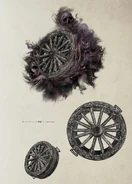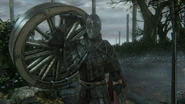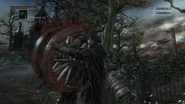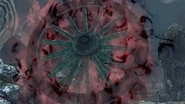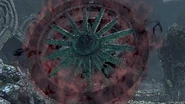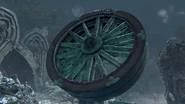| Logarius' Wheel | |||||||
|---|---|---|---|---|---|---|---|
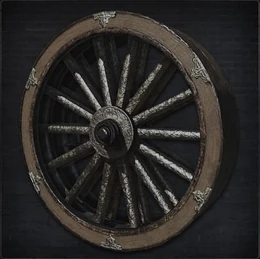
| |||||||
| Found | |||||||
| Sold by the Bath Messengers for 13,000 Blood Echoes after obtaining the Wheel Hunter Badge. | |||||||
| Stats | |||||||
| 100/200 | |||||||
| - | |||||||
| 25/50 | |||||||
| - | |||||||
| - | Attr. Bonus | ||||||
| - | |||||||
| 300 | C/S | - | - | D/C | |||
| Special Att. | Attr. Req. | ||||||
| 0 | 0 | 100 | 100 | 20 | 12 | - | 10 |
| Weapon Info | |||||||
| Weapon Type | Right Hand Weapons | ||||||
| Imprints | Normal (Radial, Radial, Triangle) | ||||||
| Aux. Effect | 30% Righteous | Deals Righteous in both modes. | |||||
| Notes | The transformed mode multiplies Arcane damage. The L2 further increases said damage. | ||||||
The Logarius' Wheel is a Trick Weapon in Bloodborne.
Description[]
In-Game Description
- Weapon wielded by martyr Logarius' band of executioners.
- Used to slaughter the Vilebloods in Cainhurst. Bathed in pools of their blood, and forever steeped in their ire.
- Transform to release the power of the wheel and manifest their lingering rage in a show of utter brilliance.
Availability[]
Normal variant[]
- Sold by the Bath Messengers after acquiring the Wheel Hunter Badge.
Uncanny variant[]
- Can be found in Root Chalice Dungeons
Lost variant[]
- Can be found in Root Chalice Dungeons
Characteristics[]
While transformed, Logarius' Wheel's damage changes; the Strength and Arcane scalings are swapped, netting a C in Strength and an S in Arcane.
The transformed wheel can be self-buffed by pressing L2.
- The wheel can be buffed three times.
- Each buff adds 10% arcane damage and a health drain of 0.1%.
- The second buff is weaker than the first, but the third buff is the strongest.
- The buff lasts roughly 30-35 seconds.
- You can reapply buffs to the weapon, but the buffs will start again from the first. This means that you must reapply three buffs to reach the third level again.
- The health drained by the buffs can be regained through combat, unlike the health drained by the Chikage.
- The buffs do not affect the transformation attack.
Upgrades[]
Notes[]
- This weapon deals 30% Righteous damage in both modes.
- Logarius' Wheel is one of only weapons able to achieve an S scaling in strength in the maingame, and one of two with the DLC (the Whirligig Saw being the other).
- In the weapon's buffed mode, the ghostly faces of Vilebloods that have been brutally smashed to pieces by the Executioners come out of the wheel's surrounding red mist.
Trivia[]
- From reading the description of the weapon, it becomes very clear that the item is cursed; in fact, it deals one of the few forms of "Accursed" Arcane damage, which occurs only from sources that are not of the cosmos.
- With the buffs from the transformed mode giving almost pure arcane damage while also wearing away at the user's health, it is essentially the parallel to the Chikage, even in the sense that the Chikage is a Vileblood weapon, while this is an Executioner weapon.
- Another of Hidetaka Miyazaki's nods to the "Berserk" manga, this weapon is wielded by an executioner.
- Its real-life version is the breaking wheel, a medieval execution method, making it a fitting weapon for the Executioners to use.
- In actual history, criminals were usually tied or nailed to the wheel and bludgeoned to death, or "displayed" on the wheel after a similar execution. The wheel itself was occasionally the tool of bludgeoning, most notably for the 1589 execution of Franz Seuboldt, for the crime of parricide. Occurring in Nuremberg, a city in Germany, two of Seuboldt's limbs were stretched out and smashed by Nuremberg's executioner Franz Schmidt. He then delivered the coup de grace, most likely done by striking Seuboldt hard on his chest and stomach, to cause lethal injury.

